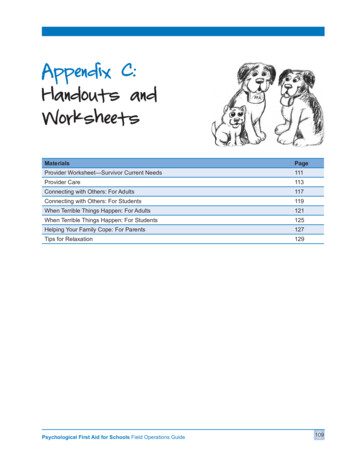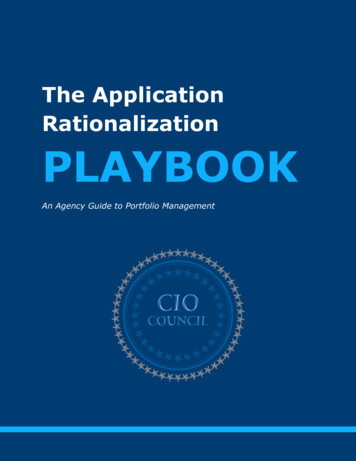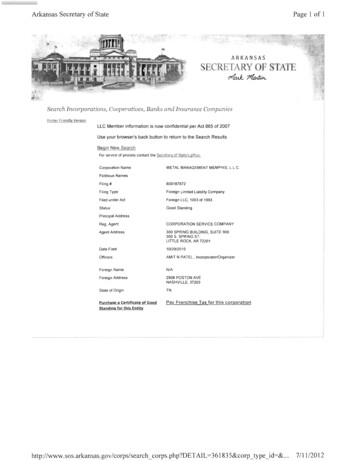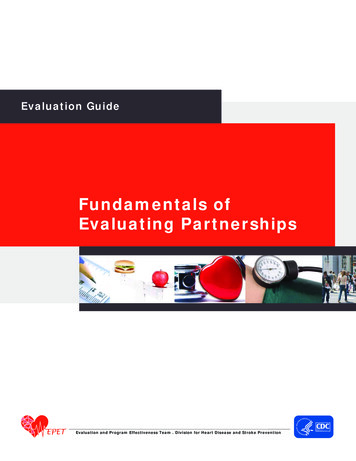
Transcription
Appendix C:Handouts andWorksheetsMaterialsPageProvider Worksheet—Survivor Current Needs111Provider Care113Connecting with Others: For Adults117Connecting with Others: For Students119When Terrible Things Happen: For Adults121When Terrible Things Happen: For Students125Helping Your Family Cope: For Parents127Tips for Relaxation129Psychological First Aid for Schools Field Operations Guide109
Handouts and WorksheetsProvider WorksheetSurvivor Current NeedsDate: Provider:Survivor Name: Location:This session was conducted with (check all that apply):o Childo Adolescento Adulto Familyo GroupProvider: Use this form to document what the survivor needs most at this time. This form can be used tocommunicate with referral agencies to help promote continuity of care.1. Check the boxes corresponding to difficulties the survivor is Acute stress reactions ooHeadachesooIncreased drug,alcohol, orprescription drug useooAcute grief reactionsooStomachachesooSadness, tearfulnessooSleep difficultiesooIrritability, angerooDifficulty eatingooDistressing dreams ornightmaresooAnxiety, fearooWorsening of healthconditionsooIntrusive thoughts orimagesooFatigue/exhaustionooDifficulty concentratingooGuilt or shameooChronic agitationooDifficulty rememberingooFeeling emotionallynumb, disconnectedooOtherooDifficulty makingdecisionsooIsolation/withdrawalooHigh-risk behaviorooRegressive behaviorooSeparation anxietyooViolent behaviorooMaladaptive copingPhysicalooDespair,hopelessnessooOther ooOtherCognitiveooInability to accept/cope with death ofloved one(s)ooPreoccupation withdeath/destructionooDifficulties completingassignments or choresooOther2. Check the boxes corresponding to other specific concerns.ooPast or preexisting trauma/psychologicalproblems/substance abuse problemsooInjured as a result of the emergencyooAt risk of losing life during the emergencyooLoved one(s) missing or deadooDisplaced from homeooAssisted with rescue/recoveryooPets missing/injured/deadooLiving arrangementsooLost job or schoolooFinancial problemsooPhysical/emotional disabilityooMedication stabilizationooConcerns about child/adolescent (for parent)ooSeparation from primary caregiver (for child)ooOtherPsychological First Aid for Schools Field Operations Guide111
Handouts and Worksheets3. Please make note of any other information that might be helpful in making a referral.4. ReferralooWithin school (specify)o Substance abuse treatmentooCommunity response agenciesooProfessional mental health serviceso Other community serviceso Medical treatmentooOther5. Was the referral accepted by the individual? o Yes112o NoNational Child Traumatic Stress NetworkNational Center for PTSD
Handouts and WorksheetsPFA-S Provider CareProviding support in the immediate aftermath of crisis can be an enriching professional and personalexperience that enhances satisfaction through helping others. It can also be physically and emotionallyexhausting. The following provides information to consider when responding to an emergency at a school.Common Stress ReactionsYou may experience a number of stress responses, which are considered common when working withsurvivors: Increase or decrease in activity level Difficulties sleeping Substance use Disconnection and numbing Irritability, anger, and frustration Vicarious traumatization in the form of shock,fearfulness, horror, helplessness Confusion, lack of attention, and difficulty makingdecisions Physical reactions (headaches, stomachaches,easily startled) Depressive or anxiety reactions Decreased social activities Diminished self-careExtreme Stress ReactionsYou may experience more serious stress responses that warrant seeking professional support or monitoringby a supervisor. These include:Sense of helplessnessPreoccupation or compulsive re-experiencing of trauma experienced either directly or indirectlyAttempts to over-control in professional or personal situations, or act out a “rescuer complex”Social withdrawal and isolationChronic exhaustionSurvival coping strategies like relying on substances, overly preoccupied by work, or drastic changes insleeping or eating patternsSerious difficulties in interpersonal relationships, including domestic violenceDepression accompanied by hopelessnessSuicidal ideation or attemptsUnnecessary risk-takingIllness or an increase in levels of painChanges in memory and perceptionDisruption in your perceptions of safety, trust, and independencePsychological First Aid for Schools Field Operations Guide113
Handouts and WorksheetsSchool administration and leadership can help support providers by reducing the risk of extreme stressthrough implementing procedures and policies. Consider: Encouraging work breaks Rotating of providers from the most highly exposed assignments to lesser levels of exposure Identifying enough supports to meet the needs of administration, staff, students, and families Encouraging peer partners and peer consultation Monitoring providers who meet certain high risk criteria, such as: those who have been directly exposedto the event, those having regular exposure to severely affected individuals or families, those with multiplestresses (e.g., family changes, health problems) Ensuring regular supervision, case conferencing, staff appreciation events Conducting trainings on stress management practices and encourage the use of such practices Supporting open communicationSelf-CareSelf-care is the ability to engage in helping others without sacrificing other important parts of one’s life. It’staking responsibility for job functions you have control over, the ability to maintain a positive attitude towardsthe work despite challenges, and your right to be well, safe, and fulfilled.It’s important to remember that self-care is not an emergency response plan to be activated when stressbecomes overwhelming or that having a good self-care plan means you are acting selfishly. Healthy self-carecan renew our spirits and help us become more resilient.Think of self-care as having three basic aspects:AwarenessThe first step is to seek awareness. This requires you to slow down and focusinwardly to determine how you are feeling, what your stress level is, what types ofthoughts are going through your head, and whether your behaviors and actions areconsistent with the who you want to be.BalanceThe second step is to seek balance in all areas of your life including work, personaland family life, rest, and leisure. You will be more productive when you’ve hadopportunities to rest and relax. Becoming aware of when you are losing balance inyour life gives you an opportunity to change.ConnectionThe final step is connection. It involves building connections and supportiverelationships with your co-workers, friends, family, and community. One of the mostpowerful stress reducers is social connection.114National Child Traumatic Stress NetworkNational Center for PTSD
Handouts and WorksheetsSelf-Care ChecklistThere are several ways you can find balance, be aware of your needs, and make connections. Use this list tohelp you decide which self-care strategies will work for you.Make every effort to:ooSeek out and give social supportooCheck in with other colleagues to discuss theresponse to the emergencyooSchedule time for a vacation or gradualreintegration into your normal lifeooPrepare for worldview changes that may not bemirrored by others in your lifeooParticipate in formal help if extreme stresspersists for greater than two to three weeksooIncrease leisure activities, stress management,and exerciseooPay extra attention to health and nutritionooSelf-monitor and pace your effortsooMaintain boundaries: delegate, say “no,” and avoidgetting overloaded with workooPay extra attention to rekindling closeinterpersonal relationshipsooAccess supervision routinely to share concerns,identify difficult experiences and strategize to solveproblemsooAnticipate that you will experience recurringthoughts or dreams, and that they will decreaseover timeooKeep a journal to get worries off your mindooAsk for help in parenting, if you feel irritable or arehaving difficulties adjusting back to your routineooPlan for family/home safety, including making childcare and pet care plansooPractice brief relaxation techniques during theworkdayooUse a buddy system to share upsetting emotionalresponsesooStay aware of limitations and needsooPractice good sleep routinesooRecognize when one is Hungry, Angry, Lonely orTired (HALT), and take the appropriate self-caremeasuresooMake time for self-reflectionooIncrease activities that are positiveooFind things that you enjoy or make you laughooPractice religious faith, philosophy, spiritualityooTry at times not to be in charge or the “expert”ooSpend time with family and friendsooIncrease experiences that have spiritual orphilosophical meaning to youooLearn how to “put stress away”ooWrite, draw, paintooLimit caffeine, cigarettes, and substance useBe careful of engaging in activities that can hinder your attempts at good self-care. Avoid: Extended periods of solo work without colleagues or working “round the clock” with few breaks Negative self-talk that reinforces feelings of inadequacy or incompetency Common attitudinal obstacles to self-care (e.g., “It would be selfish to take time to rest.”) Negatively assessing your contribution Use of excessive use of alcohol, illicit drugs, or excessive amounts of prescription drugsPsychological First Aid for Schools Field Operations Guide115
Handouts and WorksheetsConnecting with Others: For AdultsSEEKING SOCIAL SUPPORT Making contact with others can help reduce feelings of distress can benefit from spending time with other similar-age peers dults need the support of familiar adults to cope with traumatic events Support can come from family, friends, teachers, or others coping with the same traumatic eventSocial Support Options Spouse or partner Clergy Support group Trusted family member Doctor or nurse Co-worker/Teacher Close friend Counselor PetDo . . . Decide carefully whom to talk Start by talking about practical Ask others if it’s a good time Decide ahead of time what Let others know you need to Tell others you appreciate Choose the right time and Talk about painful thoughts Tell others what you need ortoyou want to discussplacethingstalk or just to be with themand feelings when you’rereadyDon’t . . . Keep quiet because you don’t want to upsetothers Keep quiet because you’re worried about beingto talktheir listeninghow they can help—nameone main thing that wouldhelp you right now Start by talking about practical things Let others know you need to talk or just to bewith thema burdenWays to Get Connected Call friends or family on the phone Get involved with a support group Increase contact with the acquaintances andfriends you have now Get involved in community recovery activities Renew or begin involvement with a church,synagogue, mosque, temple, or other groupPsychological First Aid for Schools Field Operations Guide117
Handouts and WorksheetsConnecting with Others: For AdultsGIVING SOCIAL SUPPORTYou can help family members and friends cope with the emergency by spending time with them and listeningcarefully. You may also feel better yourself when you give support to others. Most people recover best whenthey feel connected to people who care about them. Some people choose not to talk about their experiencesvery much, while others do need to discuss their experiences. For some, talking about what happened canhelp those events seem less overwhelming. For others, just spending quiet time with people who are closeand accepting can feel best. Here is some information about giving social support to other people.Reasons Why People May Avoid Social Support Not knowing what they need Not wanting to burden others Feeling embarrassed or “weak” Feeling they will lose control Doubting it will be helpful orthinking that others won’tunderstandHaving tried unsuccessfully toget help in the past Wanting to avoid thinking orfeeling about the event Feeling that others will bedisappointed or judgmental Not knowing where to get helpGood Things to Do When Giving Support Show interest, attention, andthat you care Show respect for the person’sreactions and ways of coping Talk about expected reactionsto traumatic events and healthycoping Find a time and place to talkwithout interruption Acknowledge that this type ofstress can take time to resolve Have no expectations; don’tjudge Help brainstorm positive waysto deal with his/her reactionsExpress belief that the personis capable of recovery Offer to talk or spend timetogether as many times as isneededThings That Interfere with Giving Support Rushing to tell someone that he/she will be okayor that he/she should just “get over it” Acting like someone is weak or exaggerating,because he/she isn’t coping as well as you are Discussing your personal experiences withoutlistening to the other person’s story Giving advice without listening to the person’sconcerns or asking what works for him/her Stopping the person from talking about what isbothering him/her Telling the person he/she was lucky it wasn’tworseWays to Get Connected Let the person know that experts think persistentavoidance and withdrawal are likely to increasedistress, while social support helps recovery Encourage the person to talk with a counselor,clergy, or medical professional, and offer toaccompany him/her Encourage the person to join a support groupwith others who have had similar experiences Enlist help from others in your social circle, sothat you all take part in supporting the person118National Child Traumatic Stress NetworkNational Center for PTSD
Handouts and WorksheetsConnecting with Others: For Students Talking or hanging out with other people can help you feel better. It is important to get support from both adults (family members and teachers) and peers your age (friendsand classmates). It may help to spend time with other people who have been through similar experiences.Those who can support you include: Family who live with you Extended family members whodon’t live with youClose friends/boyfriends/girlfriends Adults at school (teachers,coaches, aides, administrators)Classmates or others your agewho have had experiences likeyours School counselors or othercounselorsWhen you want to talk to someone: For example, a teacher may Decide carefully whom to talkto by thinking about a personyou trust, who listens to you,and who can help you. Choose the right time andplace to talk.not be able to talk to you whileshe is teaching class, but maybe happy to talk to you afterclass. Ask the person if it’s a goodtime to talk. Let the person know that youwant to talk. Religious leaders Doctors or nurses Pets If you don’t feel like talking,tell the person that you justwant to spend time with them. Start by telling the personwhat you need. If you feel ready, you may talkabout sad or scary thoughtsor feelings, but you don’t haveto talk about anything if youdon’t want to.Sometimes students don’t want to talk about what happened because they worry that: Other people won’t want to listen or don’t havetime to listen. They will look like they are weak or scared ifthey ask for help. Other people will be upset if they hear aboutwhat happened. If they let themselves feel sad or scared, theywill never feel better. Adults will be mad if you talk about bad thingsthat happened.Psychological First Aid for Schools Field Operations Guide–– For example, some people are scared that ifthey start crying, they won’t stop. This is nottrue; it actually helps to talk, as long as youwait until you are ready.119
Handouts and WorksheetsDo not let your worries stop you from talking to family and friends. They want to be there for you, andyou will feel better if you spend time with them.What to do: Tell a family member or friend that you would like to talk about what happened and your feelings aboutit. Tell family members or friends if you don’t feel like talking about what happened, but want to spendtime and do fun things with them. Remember that after something bad happens, it is ok to have many different feelings. Know that it is ok to spend time with people and to have fun, even during a sad time. Reach out to friends or family members by phone or internet. Get involved in support groups and community, school, or religious activities (sports, volunteering,youth groups). Support others; sometimes it will help you feel better, too.Good things to do when giving support to other people: Let people know that you are interested in how they are feeling. Understand that people have all different kinds of feelings after a traumatic event. There is no right orwrong way to react. Some people cry when they are sad; other people may feel sad, but respond by beingquiet, laughing, or seeming angry. Listen to the other person, respect his/her feelings, never make fun of the person, and encourage friendsto seek support from adults when you think it might help. It always helps to be a good friend.120National Child Traumatic Stress NetworkNational Center for PTSD
Handouts and WorksheetsWhen Terrible Things Happen: For AdultsImmediate ReactionsThere are a wide variety of positive and negative reactions that survivors can experience during andimmediately after an emergency. These include:DomainNegative ResponsesPositive ResponsesCognitiveConfusion, disorientation, worry,intrusive thoughts and images, selfblameDetermination and resolve, sharperperception, courage, optimism, faithEmotionalShock, sorrow, grief, sadness, fear,anger, numbness, irritability, guilt, andshameFeeling involved, challenged,mobilizedSocialExtreme withdrawal, interpersonalconflictSocial connectedness, altruistichelping behaviorsPhysiologicalFatigue, headache, muscle tension,stomachache, increased heartrate, exaggerated startle response,difficulties sleepingAlertness, readiness to respond,increased energyCommon Negative Reactions That May ContinueIntrusive reactions Distressing thoughts or images of the event while awake or dreaming Upsetting emotional or physical reactions to reminders of the experience Feeling as if the experience is happening all over again (“flashbacks”)Avoidance and withdrawal reactions Avoiding talking, thinking, or having feelings about the traumatic event Avoiding reminders of the event (places and people connected to what happened) Restricted emotions, feeling numb Feelings of detachment and estrangement from others, social withdrawal Loss of interest in usually pleasurable activitiesPsychological First Aid for Schools Field Operations Guide121
Handouts and WorksheetsPhysical arousal reactions Constantly being “on the lookout” for danger, startling easily, or being jumpy Irritability or outbursts of anger, feeling “on edge” Difficulty falling or staying asleep, problems concentrating or paying attentionReactions to trauma and loss reminders Reactions to places, people, sights, sounds, smells, and feelings that are reminders of the traumatic event–– Reminders can bring on distressing mental images, thoughts, and emotional/physical reactions–– Common examples include sudden loud noises, sirens, locations where the event occurred, seeingpeople with disabilities, funerals, anniversaries of the event, birthday of the deceased, and mediareports about the event or its aftermathPositive changes in priorities, worldview, and expectations Enhanced appreciation that family and friends are precious and important Meeting the challenge of addressing difficulties (by taking positive action steps, changing the focus ofthoughts, using humor, acceptance) Shifting expectations about what to expect from day to day and about what is considered a “good day” Shifting priorities to focus more on quality time with family or friends Increased commitment to self, family, friends, and spiritual/religious faithCommon Reactions When a Loved One Dies Confusion, numbness, disbelief, bewilderment, feeling lost Feeling angry at the person who died or at people considered responsible for the death Strong physical reactions, such as nausea, fatigue, shakiness, and muscle weakness Feeling guilty for still being alive Intense emotions, such as extreme sadness, anger, or fear Increased risk for physical illness and injury Decreased productivity or difficulty making decisions Having thoughts about the person who died, even when you don’t want to Longing for, missing, and wanting to search for the person who died Worry that they themselves or another loved one might die Anxiety when separated from caregivers or other loved ones Heightened sense of the role of spirituality and/or religion122National Child Traumatic Stress NetworkNational Center for PTSD
Handouts and WorksheetsWhat Doesn’t Help Doing risky things (driving recklessly, substance abuse, not taking adequate precautions) Overeating or not eating Not taking care of yourself Extreme withdrawal from family or friends Extreme avoidance of thinking or talking about the event or the death of a loved one Working too much Using alcohol or drugs to cope Excessive watching television or spending time on the internet Withdrawing from pleasant activities Violence or conflict Blaming othersWhat Helps Seeking a community religious professional Positive reminiscing about a loved one who has died Seeking counseling Taking breaks Keeping a journal Exercising in moderation Trying to maintain a normal schedule Participating in a support group Getting adequate rest and eating healthy meals Using relaxation methods (breathing exercises, meditation, calming self-talk, soothing music) Scheduling and engaging in positive activities (sports, hobbies, reading) Focusing on something practical to do right now to manage the situation Talking to another person to get support or spending time with othersPsychological First Aid for Schools Field Operations Guide123
Handouts and WorksheetsWhen Terrible Things Happen: For StudentsWhen a bad thing happens, people have many different kinds of thoughts and feelings. There is no right orwrong way to feel. Some of the ways we respond may be helpful like how being around family and friends canhelp us feel happy or safe, while some of the ways we respond can make us feel very sad, scared, or angry.A crisis can affect how you feel, how you think, and how you act.You may feel confused, worried, shocked, sad, scared, angry, guilty, or numb. Maybe even scared aboutthings that you weren’t scared of before, such as being alone, being in the dark, or getting hurt.You may have feelings in your bodies, such as: Being tired Headaches or stomachaches A fast heart beat Feeling jumpy Having problems sleepingYou may have thoughts, such as: Believing that what happened was your fault Images of the bad thing repeatedly popping into your head Nightmares Worrying that bad things will happen againYou may act differently: You may not want to be around family or friends You may get into more fights You may have a hard time concentrating or getting schoolwork done You may not want to talk about, think about, or have any feelings about the bad thing that happened You may not have as much fun as you used to You may not want to be around things that remind you of what happenedMany of these thoughts, feelings, and behaviors may occur when your reminded of the bad thing thathappened. Reminders may include places, people, sights, sounds, smells, and feelings related to the event.Psychological First Aid for Schools Field Operations Guide125
Handouts and WorksheetsWhat does NOT help when you are affected by a crisis: Staying away from fun activities Fighting Avoiding thinking about what happened Staying away from family and friends Avoiding asking for help when you need it Using drugs or alcohol Taking risks, such as climbing too high, being careless crossing the street, or driving recklesslyWhat helps when you are affected by a crisis: Talking to and spending time with family and friends Doing fun things with family and friends Eating well, getting enough sleep, and exercising Getting back to a regular schedule—doing things that you would usually do Playing outside Listening to music Keeping a journal Giving yourself extra time to do homework Accepting that you may need extra help temporarily and being willing to ask others for supportIt is okay to feel sad or scared after a bad thing happens, but if these feelings get in the way of getting alongwith family or friends or schoolwork, talk to an adult about your feelings.126National Child Traumatic Stress NetworkNational Center for PTSD
Handouts and WorksheetsHelping Your Family Cope: For ParentsReestablish Family RoutinesReestablish family routines to the extent possible after an emergency. Try to maintain routines such as mealtimes, bedtime, reading time, and playtime, and to set aside time for the family to enjoy activities together.Develop Tolerance among Family MembersAssist family members in developing a mutual understanding of their different experiences, reactions, andcourse of recovery. Encourage family members to be understanding, patient, and tolerant of differences intheir reactions to the event, and to talk about things that are bothering them, so that the others will know whenand how to support them.Family members can help each other by: Listening and trying to understand Comforting with a hug Doing something thoughtful like writing a note Getting the child’s mind off the event by playing a gameEven though family members havegone through the same crisis, theymay have very different feelings andreactions to it. These differencescan lead to misunderstandings,arguments, and an inability tosupport each other well.Pay special attention to your children’s behavior. Out of control or unusual behavior could mean that yourchildren are troubled by reminders and hardships from the event. For example, children may look as if theyare having a temper tantrum, when actually they are acting out because they have been reminded that afriend was hurt or killed.Give Special Attention to AdolescentsAdolescents may find that you are more anxious about their safety and, consequently, more restrictive in what youallow your teens to do, after the family has faced a crisis. Help adolescents to understand that this increase in yourprotective behaviors is common and usually temporary. Knowing that the “strictness” will not last forever will helpteenagers avoid unnecessary conflict as the family recovers.Common Caregiver Reactions: Setting earlier curfews Limiting adolescents from going off by themselves withoutadult supervision Insisting that teens call in frequently to let you know thatthey are safe Restricting “everyday” risks (driving a car or doingskateboarding tricks) even if you formerly permitted itPsychological First Aid for Schools Field Operations GuideParents worry more about their kids’safety after a crisis, so they oftenhave more restrictions. Remindteens to cut you some slack.This increase in supervision isusually only temporary, and willprobably drop off as things start tosettle down.127
Handouts and WorksheetsTips for RelaxationTension and anxiety are common feelings after crises. These feelings can make it more difficult to cope withthe many things that must be done to recover. Using relaxation exercises to calm yourself during the day maymake it easier to sleep, concentrate, and have energy for coping with life. These exercises can include slowbreathing, meditation, swimming, stretching, yoga, prayer, listening to quiet music, spending time outdoors.Here are breathing exercises that may help:Adults and Teens1. Inhale slowly (one-thousand one, one-thousand two, one-thousand three)through your nose or mouth, and comfortably fill your lungs.2. Silently and gently say to yourself, “I’m filling my body with calm.”3. Exhale slowly (one-thousand one, one-thousand two, one-thousand three)through your mouth, and comfortably empty your lungs.4. Silently and gently say to yourself, “I’m letting the tension drain away.”5. Repeat five times slowly.Children(practice withyour child)Let’s practice a different way of breathing that can help calm our bodies down.1. I want each of you to think about your favorite color. Okay, we are going tobreathe in through our noses or mouths. When we breathe in, we are goingto think about our favorite color and the beautiful things you connect with thatcolor.2. Next, we will breathe out through our mouths. When we breathe out, we aregoing to breathe out the gray and the uncomfortable feelings that have beenbuilding up. Let out the air, slowly and quietly.3. Let’s try it together. Breathe in really slowly and inhale thinking about yourfavorite color and the beautiful things connected to this color, while I count tothree. One, two, three. Good job. Now, while I count again, slowly let the air outwhile thinking about the color gray and all the unpleasant feelings. One, two,three. Great job. Let’s try it together again. [Remember to praise children fortheir efforts.]Tips for Families: Find a room where everyone can spread out and have his/her own space. Some family members will want to lie down, others will want to sit. Some will want to close their eyes, andsome will want to keep them open. Encourage everyone to find a way that feels most comfortable to them. Take time to practice this when everyone is calm. That way, everyone will be better able to use thebreathing exercise when they are feeling upset. For young children, turn the breathing exercise into a game. Blow soap bubbles with a wand or blow cottonballs across a tabletop. Get creative and make it fun.Psychological First Aid for Schools Field Operations Guide129
Handouts and Worksheets : 3. Please make note of any other information that might be helpful in making a referral. 4. Referral . Illness or an increase in levels of pain: . Conducting trainings on stress management practices and encourage th










